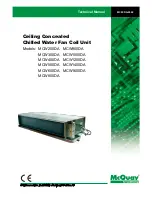
EN/10.2021/i04 © STULZ S.p.A. – all rights reserved
WLA CompACT - TRANSLATIoN oF oRIGINAL INSTRUCTIoNS
WLA CompACT - TRANSLATIoN oF oRIGINAL INSTRUCTIoNS
Area
Danger
Risk
preventative measures
Electrical box
Live power supply line even if the
switch on board the unit is OFF.
Electroshock
Make sure to disconnect the power
supply from the distribution panel.
Make sure that the main switch is not
reactivated during maintenance.
During dismantling
Area
Danger
Risk
preventative measures
Near the
unit
Losses in the refrigerant circuit;
defective refrigerant recovery
system. Consequent explosive
breakage of the refrigerant circuit.
Bruises, formation
of acid vapours with
open flames..
Wear PPE.
Near the
unit
Oil leaks during recovery.
Oil contact wit skin
or eyes
Wear PPE.
Near
water
pipes
Unscrewing the water pipes still
under pressure.
Irritation of skin and
eyes due to contact
with ethylene
glycol.. Electro-
shock. Slipping
De-pressurise the hydraulic circuit before
disconnection. Wear PPE.
Electrical
box
Live power supply line even if the
switch on board the unit is OFF.
Electroshock.
Make sure to disconnect the power
supply from the distribution panel.
Make sure that the main switch is not
reactivated during maintenance.
3.1.
Refrigerant safety data
Refrigerant safety data
1.
Identification of
the substance/
preparation
Identification of the preparation STAR COLD 134a
Recommended uses
Refrigerant
2.
Composition
/ information on
the ingredients
Tetrafluoroethane (C2H2F4)
N° CAS: 811-97-2
N° CE: 212-377-0
Concentration: 100%
3. Identification of
the hazards
Possible Hazards
Not dangerous according to Directive 1999/45/EC. Consequences on the
environment: not readily biodegradable. Physical and chemical hazards: thermal
decomposition in toxic and corrosive products.
4.
Fire-fighting
measures
Inhalation
Move the victim to a non-contaminated area wearing breathing equipment. Keep
the patient warm and at rest. Call a doctor. Apply artificial respiration if breathing has
stopped.
Contact with skin
In case of frostbite, spray with water for at least 15 minutes. Apply a sterile gauze.
And obtain medical assistance.
Contact with eyes
Immediately wash the eyes with water for at least 15 minutes.
Ingestion
Ingestion is not considered a potential route of exposure.
Protection for first-aiders
Wear suitable respiratory equipment in case of interventions in saturated atmosphere.
Notes for the doctor
Do not administer catecholamines (due to the cardiac effects of the product)
5. Fire-fighting
measures
Suitable extinguishing medium Adopt extinguishing measures in fire area.
Special risks from the
substance or mixture
The product is not flammable in ambient pressure and temperature. Any mixtures,
under pressure with air, can be flammable. At high temperature: There is thermal
decomposition into toxic and corrosive products as hydrofluoric acid and carbon
oxides.
Advice for fire-fighters
Cool containers/tanks with spraying water. Provide a rapid container evacuation
system. In case of fire nearby, keep away containers exposed to fire. In case of fire,
wear a self-contained breathing apparatus and a complete protection suit against
chemical agents.
6. Accidental
release measures
Individual measures
Try to stop the leakage. Evacuate the area. Ensure suitable ventilation. Use the
respiratory equipment to access the involved area unless atmosphere is proved
to be unbreathable. Avoid accessing sewers, basements, or any place where its
accumulation could be dangerous.
Environmental precautions.
Try to stop the leakage.
Methods and materials for
containment and recovery
Ventilate the area.
12
12













































